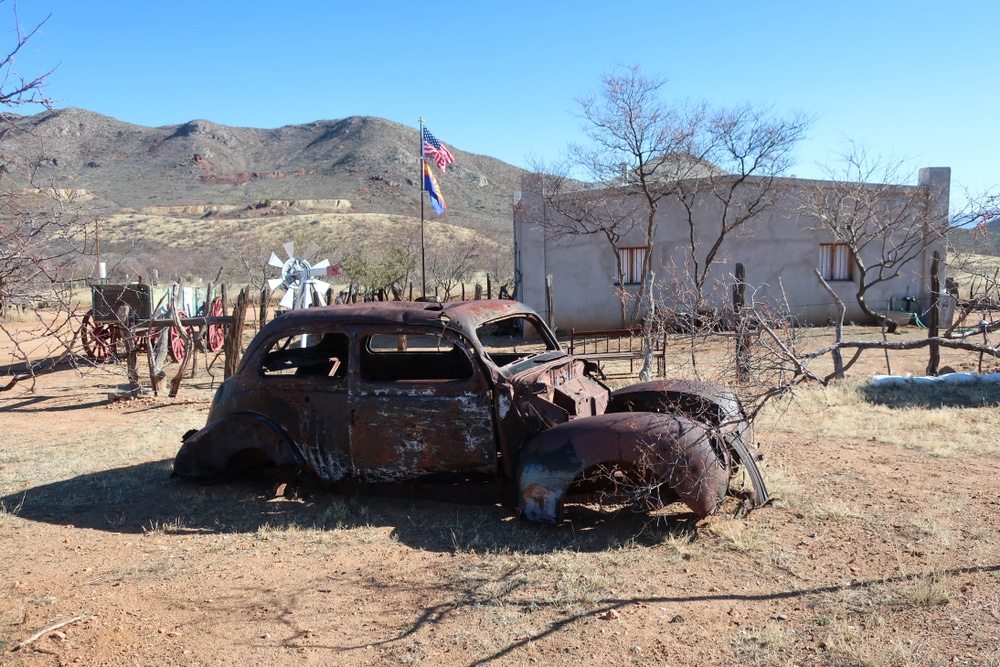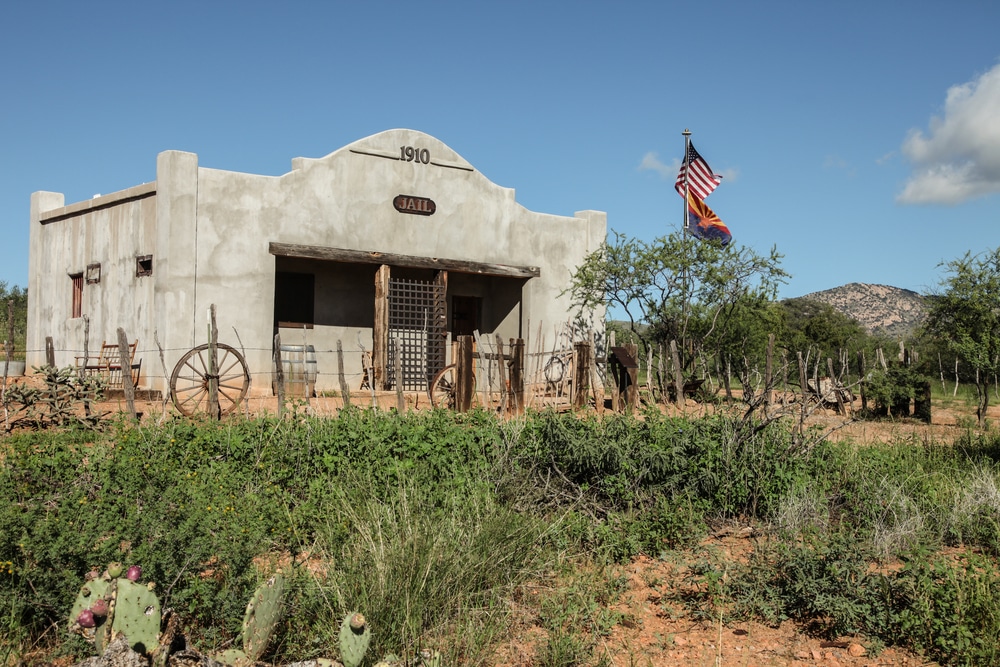The desert wind whispers through crumbling adobe walls and rusted mining equipment, carrying echoes of pickaxes and laughter across the high desert landscape of Cochise County. Here, beneath the vast Arizona sky, lies Gleeson—once a bustling copper mining community, now a silent testament to the boom-and-bust cycle that defined so many western settlements. As you stand among the scattered ruins, it’s easy to imagine the streets alive with miners, merchants, and families who built their lives here, all their hopes and dreams now preserved only in memory and in the quiet cemetery on the hillside.

The centerpiece of Gleeson today is its beautifully restored 1910 jail. Now a small museum, it features local artifacts, mining memorabilia, historical photos, and stories of law enforcement in the wild frontier days. The jail is typically open on the first Saturday of each month or by special arrangement with local volunteers.
Just outside of town lies the Gleeson Cemetery, a poignant and peaceful site with graves dating back to the early 1900s. It tells the stories of miners, settlers, and families who braved the harsh desert conditions. The cemetery is particularly atmospheric at sunrise or sunset.
Although abandoned, the skeletal remains of the Gleeson hospital and school provide fascinating glimpses into the town’s once-bustling community. Visitors can walk around (respectfully and from a safe distance) to see the adobe and stone structures slowly being reclaimed by the desert.

Gleeson is part of Arizona’s famous Ghost Town Trail, which includes nearby destinations such as Tombstone, Courtland, and Pearce. A drive along this historic route offers panoramic desert views, fascinating ruins, and opportunities to explore multiple ghost towns in one day.

Gleeson was once known for its copper, silver, lead, and turquoise mines. While the mines themselves are not open to the public, you can still spot old shafts, tailing piles, and machinery scattered around the hills—reminders of a booming industry that once drew hundreds to this area.

With its dramatic desert backdrops, crumbling buildings, and rugged terrain, Gleeson is a dream for photographers. The interplay of light and shadow across old stone walls and open skies makes for hauntingly beautiful images.

The surrounding desert and scrubland are home to a variety of birds and animals, including roadrunners, hawks, lizards, and javelinas. Bring binoculars if you enjoy nature watching during your visit.

Just 16 miles away, Tombstone offers a livelier Old West experience with reenactments, museums, and saloons. Gleeson provides a quieter, more introspective counterpart—perfect for a well-rounded historical day trip.
Gleeson’s remote location means almost no light pollution, making it an ideal spot for stargazing. On clear nights, the Milky Way is easily visible, and the peaceful desert setting creates a serene atmosphere for skywatchers.
Among those laid to rest in Gleeson’s cemetery are individuals whose stories illuminate the broader historical context. There’s José Ramírez, who came north from Sonora, Mexico to work in the mines, bringing mining skills developed in the older and more established Mexican mining tradition. His grave marker, with inscriptions in both English and Spanish, represents the bicultural character of many Arizona mining communities.
Another notable resident was Sarah Collins, who operated one of Gleeson’s boarding houses. Census records and newspaper mentions suggest she was a widow who created a new life for herself by providing clean, respectable accommodations for single miners. Her entrepreneurial spirit exemplified the opportunities the frontier offered to women who might have had fewer options in more established communities.
The grave of Thomas McKinney, a mine supervisor killed in a shaft collapse in 1912, tells yet another aspect of the Gleeson story. Newspaper accounts of his funeral describe how operations ceased for a day so that all miners could attend, demonstrating the tight-knit nature of the community despite differences in role and status.

| Category | Details |
|---|---|
| Name | Gleeson, Arizona |
| Type | Ghost town |
| County | Cochise County |
| Founded | 1900 (modern town); original mining camp “Turquoise” dates to the 1870s |
| Status | Abandoned but partially preserved; some structures still stand |
| Population (Historic) | ~500–600 during peak mining years |
| Population (Current) | None permanent; occasional caretakers or private landowners |
| Historical Significance | Mining town known for copper, turquoise, silver, and lead |
| Original Settlement | Site of earlier camp called Turquoise, abandoned in the 1890s |
| Major Mine | Copper Belle Mine, plus several smaller shafts |
| Post Office | Operated from 1900 to 1939 |
| Decline Factors | Ore depletion, fire damage, and economic downturns |
| Remnants Today | Gleeson Jail (restored as a museum), hospital ruins, school foundation, mine debris |
| Nearby Ghost Towns | Courtland, Pearce, and Tombstone |
| Access | Located off Gleeson Road, east of Tombstone and southeast of Pearce |
| Elevation | Approx. 5,000 feet (1,524 meters) |
| Climate | High desert – mild winters, warm summers |
| Best For | Ghost town explorers, photographers, mining and Wild West history buffs |
Gleeson’s story began with copper, the mineral that shaped so much of Arizona’s development. The settlement arose after John Gleeson, the town’s namesake, filed several claims and opened the successful Copper Belle Mine in the late 19th century. What was initially a small mining camp grew steadily as the demand for copper increased with America’s industrial expansion and electrification.
By 1900, approximately 500 people called Gleeson home, with most working in the local mines. Some sources suggest that during its heyday, the population may have swelled to over 1,000 residents. The town was part of the rich mining district that included nearby Courtland and Pearce, forming a triangle of activity that helped define southeastern Arizona’s economy in the early 20th century.
Gleeson represented the classic western mining town story—a community born not of gradual settlement but of sudden opportunity, drawing prospectors, laborers, merchants, and entrepreneurs from across the country and beyond. Unlike agricultural communities that evolved slowly with the seasons, Gleeson pulsed with the immediate urgency of extraction, processing, and shipping its valuable copper ore.
Today’s visitor to Gleeson encounters a landscape of contrast—the natural beauty of the Dragoon Mountains backdrop against the weathered remains of human ambition. Adobe walls stand in various stages of collapse, some barely knee-high while others maintain enough structural integrity to suggest the buildings they once formed. The restored jail, a sturdy stone structure with barred windows, serves as the most intact reminder of the town’s institutional infrastructure.
Scattered across the site are the oxidized remnants of mining equipment—ore carts, boilers, and machinery parts—slowly returning to the earth from which their metal was originally extracted. Foundations outline where homes, businesses, and community buildings once stood, offering a ghostly footprint of the town’s layout.
The Gleeson Road cuts through what was once the main street, with the jail, a partially reconstructed store, and the remnants of the school visible to passersby. Unlike some ghost towns that have been heavily vandalized or salvaged, Gleeson retains enough authentic material to give visitors a genuine sense of connection to its past.
Perched on a gentle slope overlooking the town site, the Gleeson Cemetery offers perhaps the most poignant connection to the community’s human story. This Cochise County burial ground contains the remains of the diverse population that made their lives in this remote mining settlement.
The cemetery’s weathered headstones and markers—some professionally carved, others handmade—tell tales of lives cut short by mining accidents, disease outbreaks, and the harsh realities of frontier existence. Names engraved in stone reflect the multicultural nature of mining communities: Anglo, Hispanic, European, and occasionally Chinese surnames indicate the global draw of America’s mining opportunities.
Among the more notable features are several children’s graves, a sobering reminder of high infant and child mortality rates in an era before antibiotics and modern medical care. Family plots tell stories of multiple tragedies, with some parents outliving several children, while others show the opposite—entire families wiped out by contagious diseases, leaving no descendants to maintain their memory.
The cemetery’s location, elevated above the town, follows a common pattern in mining communities—the dead were often buried uphill from settlements to prevent groundwater contamination, a practical consideration that coincidentally provided the deceased with an eternal view of the community they helped build.
While Gleeson might not have developed separate pioneer and community cemeteries like larger towns, its burial ground reflects distinctions in status and means. Wealthier residents and mine officials generally have more elaborate markers, while laborers often rest beneath simpler stones or wooden crosses that have long since disintegrated.
The cemetery’s organization tells us something about community structure as well. Family groupings show the importance of kinship networks in providing security and solidarity in this remote location. Religious symbols—crosses, Stars of David, and occasionally Masonic emblems—indicate the spiritual diversity that coexisted within the town’s physical boundaries.
Burial records, though incomplete, suggest that Gleeson’s cemetery served not just the town itself but outlying ranches and smaller mining operations. It functioned as a regional final resting place in an area where transportation was difficult and formal services limited.
While specific records of newspapers published in Gleeson itself are sparse, the town would have been covered by regional publications like the Tombstone Epitaph, Bisbee Daily Review, and the Arizona Daily Star. These papers reported on mining developments, accidents, crime, and social events, providing valuable historical context for understanding Gleeson’s place in the regional community.
Mine production figures, announcements of new claims, and technical improvements regularly made the business pages, while accounts of dances, school events, and community celebrations appeared in social columns. The papers also chronicled labor disputes, a common feature of early 20th century mining communities as workers organized to demand better conditions and compensation.
Advertisements in these publications offer glimpses into daily life—local merchants promoting their wares, stagecoach and later automobile services connecting Gleeson to larger settlements, and notices of public meetings and civic improvements. Through these fragmented records, we can reconstruct something of the rhythm of life in Gleeson during its productive years.
Though Gleeson never became a major railroad hub like nearby Fairbank, transportation infrastructure was crucial to its existence. Copper ore had to be transported efficiently to smelters and markets beyond the isolated mining district. Roads connected Gleeson to Courtland and Pearce, and eventually to the Southern Pacific Railroad line that ran through the San Pedro Valley.
The arrival of reliable transportation transformed Gleeson from a remote prospector’s camp to a functioning industrial community. Supplies, mail, and new residents could arrive more regularly, while ore shipments could reach processing facilities more efficiently, maximizing the mines’ profitability.
Evidence of these transportation networks can still be seen in the remnants of wagon roads, later improved for automobile traffic, that radiate from the town site. The development and maintenance of these routes represented significant community investment and reflected Gleeson’s economic importance to the wider region.
Gleeson’s decline began gradually in the 1920s and accelerated in the 1930s. Falling copper prices after World War I reduced profitability, while more accessible deposits began to be exhausted, requiring deeper and more expensive mining operations. The Great Depression dealt a severe blow to many marginal mining operations, forcing closures and triggering population loss.
Fire proved another enemy of Gleeson’s longevity. A major conflagration in 1912 destroyed significant portions of the business district, and though some rebuilding occurred, the town never fully recovered its momentum. Subsequent fires damaged other sections, gradually eroding the town’s building stock and community cohesion.
By the late 1930s, Gleeson’s population had dwindled significantly, and the post office—often the last institution to leave a dying town—closed in 1939. Mining continued on a smaller scale through the 1940s, but Gleeson as a viable community had effectively ceased to exist, with most residents relocating to larger towns with more diverse economic opportunities.
Today, Gleeson represents an important chapter in Arizona’s mining heritage and offers valuable insights into early 20th century industrial communities. Unlike copper giants like Bisbee that evolved into sustainable towns through diversification, Gleeson illustrates the fragility of single-industry settlements and the impermanence of boom economies.
The town site has been studied by historians and archaeologists interested in mining technology, community development, and cultural patterns in the American West. Material remains—from industrial equipment to household items—provide tangible connections to the daily lives of those who participated in Arizona’s mineral extraction economy.
For descendants of Gleeson residents, the site offers personal connections to family history. Some former residents and their children maintained ties to the community even after its decline, occasionally returning for informal reunions or to maintain family graves, keeping alive the social connections that once defined life in this now-quiet place.
The Gleeson Cemetery, like many associated with ghost towns, faces ongoing conservation challenges. Natural erosion, vegetation growth, and occasional vandalism threaten the physical integrity of markers and the site itself. At the same time, the remote location has protected it from some of the development pressures that have destroyed other historic cemeteries.
Preservation efforts have been primarily grassroots, with descendants, historical societies, and interested volunteers periodically undertaking cleaning and documentation projects. These initiatives have helped record inscriptions before they become illegible and have maintained basic access to the site for those wishing to visit ancestral graves.
Memorial practices associated with the cemetery have evolved over time. While regular maintenance and decoration of graves declined as the town emptied, occasional commemorative events have kept some traditions alive. Day of the Dead celebrations reflect the Hispanic influence in the region, while more recent historical interest has spawned educational tours that honor the cemetery’s residents through storytelling.
Modern visitors to Gleeson encounter a site that straddles the boundary between public history and private memory. The town site and cemetery are accessible by public roads, but responsible visitation requires respect for both the physical remains and the cultural heritage they represent.
Ethical guidelines for ghost town visitors include:
Photography is generally acceptable for personal and educational purposes, though commercial use may require permissions. Rubbings of grave markers are discouraged as they can accelerate deterioration of already weathered stones.
As shadows lengthen across Gleeson’s scattered ruins and cemetery, the visitor gains a profound sense of the cyclical nature of human endeavor. What once thundered with industrial activity and hummed with community life now stands silent but eloquent, a three-dimensional historical document written in adobe, stone, and metal.
The true value of places like Gleeson lies not in romantic notions of the Old West but in the authentic stories they preserve—stories of labor and capital, immigration and settlement, success and failure. In the weathered headstones of the cemetery and the crumbling walls of the town, we can read the narrative of ordinary people who, through their daily efforts, shaped the development of Arizona and the American West.
Gleeson reminds us that communities are ultimately ephemeral, subject to economic forces larger than themselves. Yet it also demonstrates how the physical traces of human activity endure, allowing later generations to connect with the past in immediate, tangible ways. As long as its ruins stand and its cemetery remains, Gleeson continues to speak across time, inviting us to listen to voices that would otherwise be lost to history.